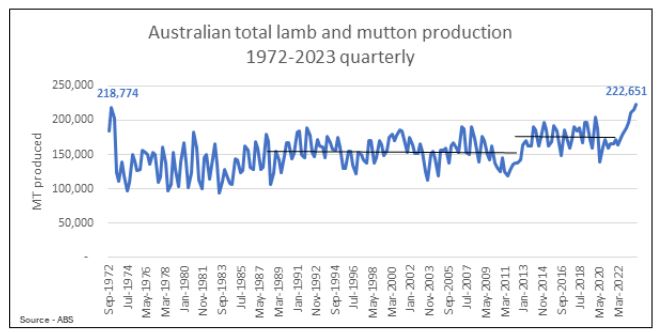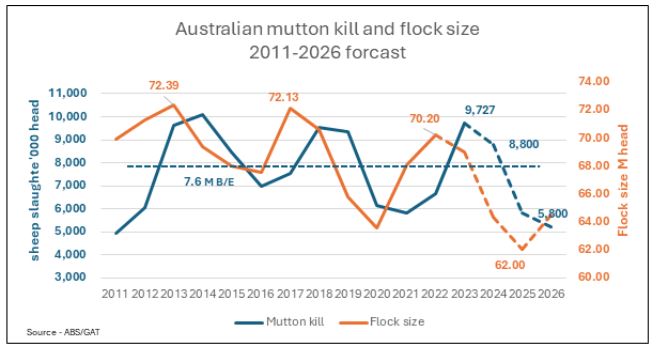Independent Livestock Analyst, Simon Quilty of Global Agri Trends shares his forecast for sheep prices over the short and long term.

In general, we have seen some firming in lamb and mutton prices to start 2024.
As the months pass, the Australian sheep flock continues to liquidate with the mutton kill (which reflects the female kill) sitting at a 10-year high. Whilst we saw some price increases in key regions to start the year, production has reached record levels, with some oversupply resulting in poorer pricing.
When the sheep and lamb kills were combined in Q4 of 2023, it totalled a record 222,651 megaton (MT). This is not on the back of a large flock, but related to the highly efficient production of lambs.
 Graph showing Australian total lamb and mutton production, from 1972 to 2023 quarterly. Source: ABS
Graph showing Australian total lamb and mutton production, from 1972 to 2023 quarterly. Source: ABS
Unlike beef, the price lift in lamb to start 2024 might be short-lived due to the ability to ramp production up quickly when the right price signals appear.
The sector may encounter issues due to the lack of workforce capacity in processing to handle the increased slaughter number of close to 8 million head.
The long-term break even on mutton kill is 7.6 million head, and in 2023 more than 9.7 million sheep were slaughtered; the expectation is that this year will continue to see a large sheep kill, at close to 8.8 million head as the flock continues to liquidate.
It should be noted that the mutton kill is made up of ewes with hardly any wethers being retained. Hence, a heavy mutton kill reflects a heavy female sheep kill and liquidation, and a low mutton kill reflects ewe retention and a rebuilding process.
 Graph showing mutton kill and flock size 2011 to 2026 forecast. Source: ABS/GAT.
Graph showing mutton kill and flock size 2011 to 2026 forecast. Source: ABS/GAT.
When assessing on a state-by-state basis, NSW has had the longest and heaviest liquidation period over seven months compared to 5 months in both Victoria and SA; there has been no liquidation so far in SA.
Further liquidation is expected for most of this year, with a strong flock rebuild expected to commence in 2025.
Please note: this article contains information of a general nature, and does not take into account your personal objectives, situation or needs. Before acting on any information, you should consider the appropriateness of the information provided, and seek advice on whether it is fit for your circumstances.
